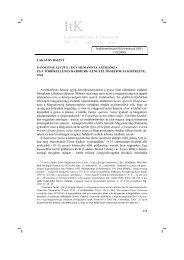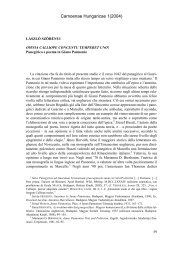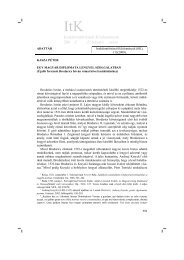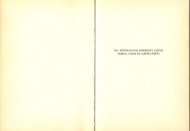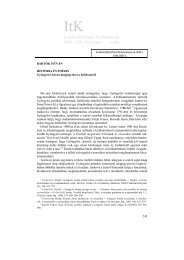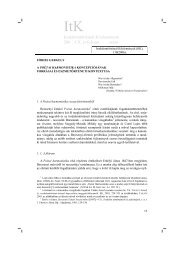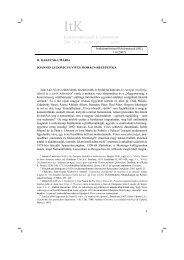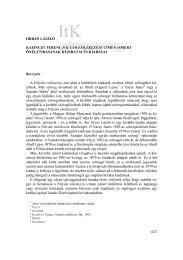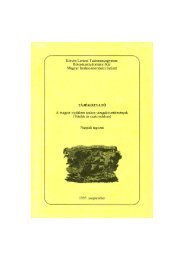Camoenae Hungaricae 3(2006) - Irodalomtörténeti Közlemények
Camoenae Hungaricae 3(2006) - Irodalomtörténeti Közlemények
Camoenae Hungaricae 3(2006) - Irodalomtörténeti Közlemények
Create successful ePaper yourself
Turn your PDF publications into a flip-book with our unique Google optimized e-Paper software.
<strong>Camoenae</strong> <strong>Hungaricae</strong> 3(<strong>2006</strong>)<br />
Cantacuzino), 77 and Saxons (Valentin Frank von Frankenstein). 78 Most of the sources<br />
were copied or transcribed by Vitezović himself. 79 (The Dalmatia debate sketched out<br />
above can be reconstructed on the basis of his writings to be found here.) This joint collection<br />
of sources was later used by both Marsili and Vitezović—in fact the two probably<br />
mutually influenced and shaped each other’s research methods and scientific ideals.<br />
The particular goal of the Croatian scholar was to organise and correct earlier historiographical<br />
tradition. His most prominent precursor and opponent was the Croatian Ivan<br />
Lučić (Giovanni Lucio, Joannes Lucius), the author of De regno Dalmatiae et Croatiae<br />
which was published a few decades earlier and by and large indirectly served the interests<br />
of Venice. 80 In essence, Vitezović wanted to overwrite this work using the new sys-<br />
used in the territorial negotiations with the Turks. On the other hand, it touches upon a political problem when<br />
it remarks that it would be difficult to secure the court’s acceptance of a concept of a Croatia which recognises<br />
no crown superior to it.<br />
75<br />
Nikola Gothal de Gothalovecz (1687–1723) was a person of key importance for Marsili, for it was he<br />
who copied the charters in the Archives of the Zagreb Chapter which Vitezović used to support the claims of<br />
the Disertatio regni Croatiae. In his letters to the Imperial Commissioner, he provides important information<br />
regarding the dimensions of the dioceses (Zagreb, 26 February, 1700: BUB Ms 103, 97r–98r; Zagreb, 12 June,<br />
1700: ibid., 140r); these also show that Marsili was willing to subsidise the Illyrian studies of a certain number<br />
of students in his home town, no doubt in exchange for copies of necessary documents. Between 1693 and<br />
1695, Gothal was the rector of the Illyrian–Hungarian College in Bologna, after 1700 a canon in Zagreb and<br />
episcopal vicar. (See Ljudevit IVANČAN, Podatci o zagrebačkim kanonicima, 1193–1924, II, 668–671; I thank<br />
the staff of the Nadbiskupski arhiv in Zagreb for providing me access to this valuable manuscript work.)<br />
76<br />
Francisci LADANJI, De gestis Banorum Regni Sclavoniae, BUB Ms 103, 237–276, the first few pages<br />
are printed (cf. VERESS 1906, op. cit., 34). Ladanji (Ladányi), in the service of the Draskovics family, prepared,<br />
besides his “Banology” (the other manuscript at Zagreb, Nacionalna i sveučilišna knjižnica, R 3249), a<br />
genealogy of the family as well (Fructus honoris in arbore Illyrico Hungarica domus Draskovithianae, 1675,<br />
Zagreb, Nacionalna i sveučilišna knjižnica, R 3572). On the author, see BENE 2001, op. cit., 20.<br />
77<br />
Constantin Cantacuzino, Wallachian boyar and historian, provided information, at Marsili’s request, on<br />
the Latin origins of the Romanians and the wildlife of Moldova and Wallachia (Catalogo dei Principi della<br />
Wallachia e della Moldavia, BUB Ms 57, 191–201), accompanying letter (ibid., 203–204) dated 4 March,<br />
1694. Cf. VERESS 1906, op. cit., 22. On his good relations to Cantacuzino: Autobiografia, 151; STOYE 1994,<br />
op. cit., 113–114; and Ramiro ORTIZ, Per la storia della cultura italiana in Rumania, Bucureşti, 1916, 187–<br />
194 (thanks to Levente Nagy for this last reference).<br />
78<br />
NAGY (2000, op. cit.) thinks it possible that this Saxon Royal Magistrate collaborated in the collection<br />
of information on Transylvania.<br />
79<br />
Apart from the already cited Responsio, Croatia, Disertatio regni Croatiae, Prodromus, Denominationes,<br />
and the copy of Forstall’s Stemmatographia, the following documents are in the autograph of the Croat<br />
scholar: De Valachis, sive vlahis (BUB Ms 103, 139r); Authores qui de Illyrico et Croatia scripserunt (ibid.,<br />
14r–15v); Notae de titulis regum Croatiae, Serbiae et Ungariae (ibid., 19r–20r); Antiquae Romanor[um]<br />
inscriptiones, quae per Croatiam visuntur (ibid., 22r–23v; Zagreb copy: Arhiv Hrvatske akademije znanosti i<br />
umjetnosti, III. d. 194); Cathalogus familiarum in libro insigniorum Illyricae nobilitatis comprehensarum<br />
(ibid., 132r–138r; drawings of coats of arms are attached to this in the volume).<br />
80<br />
Joannes LUCIUS, De regno Dalmatiae et Croatiae libri sex, Amstelodami, 1666. See Miroslav KURE-<br />
LAC, Ivan Lucić Lucius, otac hrvatske historiografije, Zagreb, 1994. The upshot of decades of “wrestling”<br />
with Lucio was a voluminous bundle of refutations, in manuscript form, written by Vitezović: Offuciae Joannis<br />
Lucii de Regno Dalmatiae et Croatiae refutatae (around 1706, Zagreb, Nacionalna i sveučilišna knjižnica,<br />
R 3454). On the relationship between the texts of the two scholars: BLAŽEVIĆ 2002, op. cit., 130–134.<br />
133



